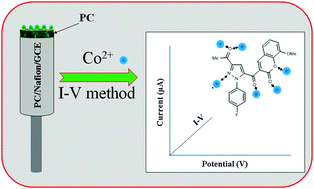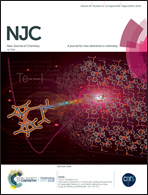Synthesis of novel pyrazole incorporating a coumarin moiety (PC) for selective and sensitive Co2+ detection
Abstract
In this study, an efficient regioselective synthesis of a novel pyrazole derivative containing a coumarin moiety (PC) was achieved. Unambiguous structural assignment of the obtained regioisomers was performed using two-dimensional heteronuclear multiple bond correlation (2D HMBC) NMR spectroscopy as a valuable tool. A Co2+ ion-selective electrochemical sensor was fabricated by depositing the synthesized pyrazole derivative on a glassy carbon electrode (GCE) and the electrochemical method was investigated in detail in phosphate buffer medium. The proposed Co2+ ion sensor exhibited a linear relationship for current vs. Co2+ ion concentration in the concentration range of 0.1 nM to 0.01 mM, denoted as the linear dynamic range, demonstrating an appreciable sensitivity of 19.9146 μA μM−1 cm−2. From a signal-to-noise ratio of 3, the estimated limits of detection and quantification were 94.04 ± 4.70 pM and 313.47 pM, respectively. The Co2+ ion sensor comprising PC deposited on a GCE showed good electrochemical sensing performance, with precise reproducibility, a short response time, and good reliability. The proposed Co2+ ion sensor provides an efficient route to detect Co2+ ions for environmental remediation using pyrazole derivatives.



 Please wait while we load your content...
Please wait while we load your content...